The Acer Swift 3 SF315-41 Review: Ryzen Meets Laptop
by Brett Howse on May 3, 2018 8:00 AM EST- Posted in
- Laptops
- Acer
- AMD
- Ryzen
- Ryzen Mobile
- Raven Ridge
Display Analysis
Acer has outfitted the Swift 3 with a 1920x1080 IPS display, which is a big improvement over the TN displays that used to plague AMD based systems. This is a display with a Corning Gorilla Glass cover, but there’s no touch.
To test the display capabilities, we leverage SpectraCal’s CalMAN software suite, along with an X-Rite i1DisplayPro colorimeter for brightness and contrast, and an X-Rite i1Pro2 spectrophotometer for color accuracy testing.
Brightness and Contrast
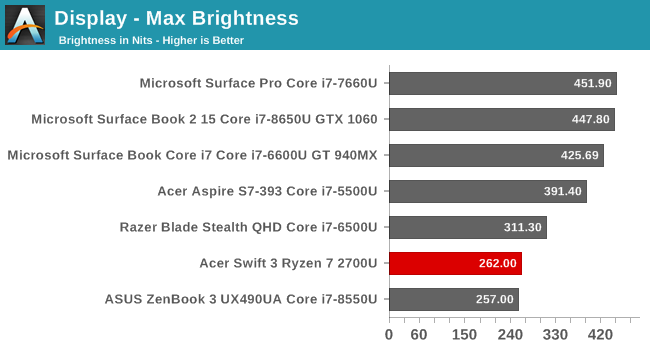
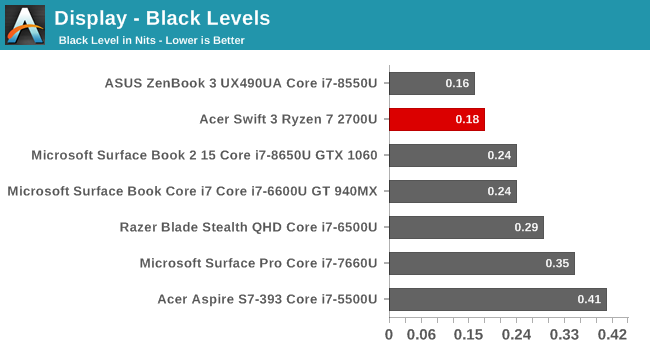
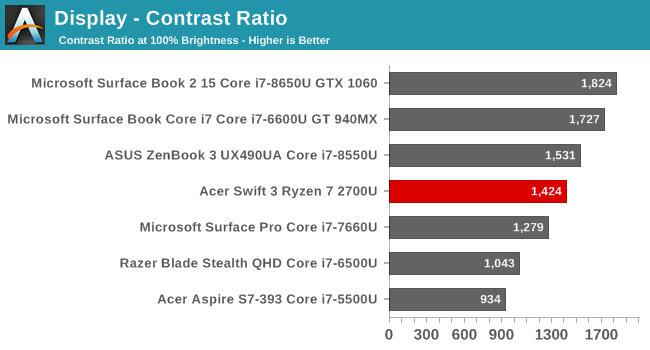
The Acer doesn’t come close to other laptops in terms of overall brightness, at just 260 nits, so outdoor usage, especially with the glass over the display, is going to be a challenge, but the black levels are very good, so the contrast ratio is very solid. The display goes down to 20 nits, which is still fairly bright, but would be fine in a dim room. This isn’t a tablet you’d use in bed, so there’s likely no need to go down to the low single-digits we see on some devices.
Grayscale
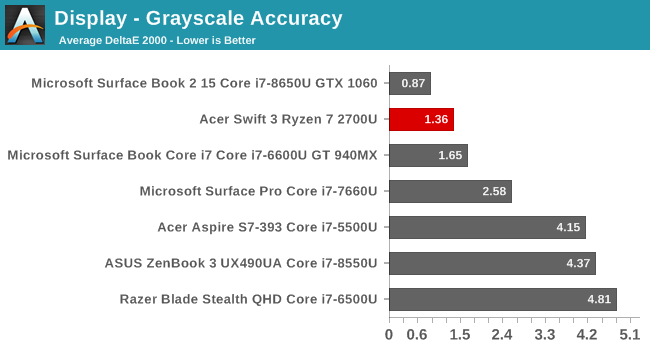
Here was a surprise. Acer absolutely delivers in terms of grayscale out of the box, with fantastic RGB balance, and a great average result without the big spikes we sometimes see closer to 100% white on some systems. Gamma is a bit low, but still close to the 2.2 level we’d like to see.
Gamut

Here’s a good sign that Acer considers the Swift 3 a lower-tier model. This display doesn’t even come close to covering the entire sRGB gamut, with all three primary colors short of the target at 100%. The blue results are especially terrible, with an error level of 17.6 at 100% when you’re looking for a result under 3.0.
Saturation

This is just a more comprehensive view of the gamut results, so it’s not surprising to see a less than amazing average error level here too. All of the sweeps are well short of the targets, and the error levels start to creep up very early.
Gretag Macbeth
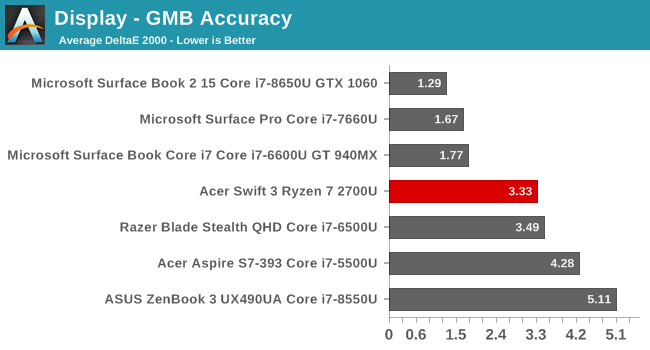
The GMB test is the most comprehensive, covering not just the primaries and secondaries, but also various colors in between, and the important skin tones. With the lack of gamut coverage, there’s plenty of errors here, but for the most part, they are a lot less severe than the pure primaries.
The following image shows the target color on the bottom and the actual displayed color on the top. This image will be relative though because any errors in your own display will prevent an absolute look at the differences, but you can still clearly see the excellent grayscale results, marred by the lack of gamut coverage on the deeper colors.
Display Conclusion
This is definitely a mixed bag conclusion. Acer is targeting a lower price bracket on the Swift 3, and that shows when you see a display that is this far short of covering all of sRGB, but at the same time, they offer some of the best out of the box grayscale results we’ve seen outside of perhaps a Surface device. Still, at a $949 MSRP for the laptop tested, it would be nice to see a display that can cover all of sRGB.
The 1920x1080 resolution is the perfect fit for this laptop as well, allowing Acer to keep the price down, but still offering enough resolution for a 15.6-inch device. You can easily run this at 100% scaling, which avoids any issues you’d see with higher resolution laptops, although most of those issues are a huge problem anymore.















78 Comments
View All Comments
jaydee - Thursday, May 3, 2018 - link
Looking forward to Ryzen hitting the business line notebooks (Elitebook/Latitudes). Lot of employees at my company are still being given the woeful Elitebook 745 G3 (Carrizo) as of today, as band new laptops for a 4 year cycle...Jimster480 - Monday, May 28, 2018 - link
They did, and the offerings are atrocious and insanely overpriced.Valantar - Thursday, May 3, 2018 - link
This is very promising in terms of performance, even if AMD still needs to convince OEMs to build more premium SKUs with Ryzen mobile. Also, that base platform power draw needs fixing, for sure. Wonder how much of that is RAM, but I suppose that would be pretty much impossible to measure.Related to that: why doesn't RAM have some sort of turbo/power saving implementation like CPUs? Given that this likely runs dual channel 1.2V DDR4 at ~2400MT/s, couldn't the base power draw benefit massively from downclocking the RAM to, say, 1600MT/s at idle and simultaneously lowering voltage? I get that this isn't part of the DDR4 spec, and that the ICs and DIMMs as such aren't tested or certified for lower voltages and speeds, but the lack of dynamism in RAM is starting to feel old. The same goes for high-speed desktop RAM, really - why run 3600MT/s RAM idling at the desktop? It can't possibly be /that/ hard to implement a two-state (e.g. "low power" and "normal") dynamic system that's directly tied to other system loads (not just CPU, but GPU, RAM, network and disk activity too). Tuning the boost/de-clock triggers and control algorithms would likely require a bit of work, but is this really that hard to do?
I suppose this could trip up a few applications that are highly reliant on timely RAM access, but those can't be very common in normal consumer usage - and I don't envision this catching on in datcenters and the like. Might that be why we still haven't seen something like this, as businesses and server OEMs don't care?
DanNeely - Thursday, May 3, 2018 - link
If idle link throttling of DDR ever happens, I'd expect it to happen first on mobile, and then work its way up though LPDDR, to regular DDR specs. OTOH GDDR has been able to do this for a while, so it's definitely doable without seriously impacting peak performance. GPUs are power pigs, and lower idle power has been a major improvement over the last decade; but it's a segment not willing to sacrifice performance at the top to get it.You're probably right about it never making it to the data center. I've read that a number of the major cloud platforms have disabled CPU clock throttling and run at full speed 24/7 regardless of the actual load because serving responses at low speed and/or boosting back up from idle to full speed have measurable impacts on latency and the major web companies care about every millisecond there.
neblogai - Friday, May 4, 2018 - link
Gaming benchmarks show mobile Raven Ridge processors doing exactly that: RAM clock changes in the game, 933-1066-1200. You can see such behaviour in TechEpiphany's videos on youtube. However- because this is not something seen before- these readings are semi-discarded. In would be great if someone tested it properly, or asked AMD if this is how it really works, and is not an error by monitoring software.HStewart - Thursday, May 3, 2018 - link
I think for comparison, it would have been nice to test the Intel version of same model - I found it interesting that 2700 version was more expensive than the Intel with MX150. Also the Intel model was less weight which tells me Intel components are more compact. The 2700 model had more ssd but that should not be that way.Cooe - Thursday, May 3, 2018 - link
It's because of the doubled SSD size that the 2700 model is more expensive obviously.Jimster480 - Monday, May 28, 2018 - link
Its not that because the AMD machines are relegated to cheap SATA bottom of the barrel drives and ultra cheap screens. The price is just Intel making sure that nobody is going to make a competitive notebook.This laptop doesn't even land in "mainstream" it lands in "ultra budget with such a big price nobody will buy it". The screen, SSD, battery, wifi, chassis, keyboard are all unacceptable for this price range and Acer knows it aswell. But the check they receive from intel outweighs the obvious lack of sales they will have for this model.
Stuka87 - Thursday, May 3, 2018 - link
I would be surprised if you could tell the weight difference between the two. Its 4 ounces. And the Intel is cheaper because its SSD is half the size.Krysto - Thursday, May 3, 2018 - link
Still only 8GB of RAM?! Come on.